汽车实用英语(一)自学考试大纲
- 格式:doc
- 大小:35.50 KB
- 文档页数:7
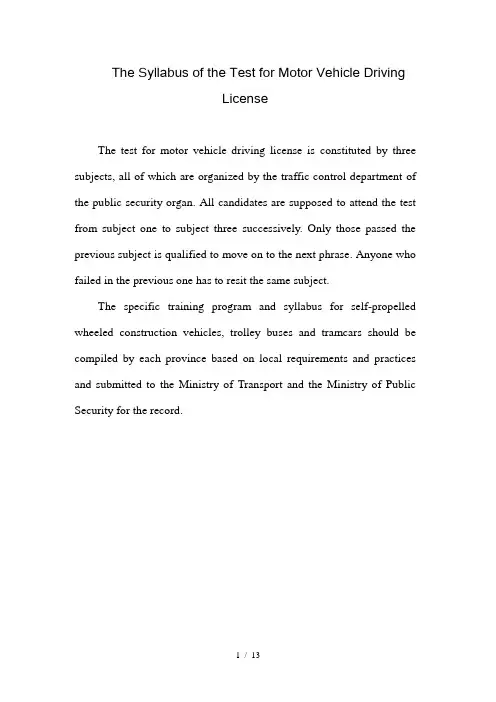
The Syllabus of the Test for Motor Vehicle DrivingLicenseThe test for motor vehicle driving license is constituted by three subjects, all of which are organized by the traffic control department of the public security organ. All candidates are supposed to attend the test from subject one to subject three successively. Only those passed the previous subject is qualified to move on to the next phrase. Anyone who failed in the previous one has to resit the same subject.The specific training program and syllabus for self-propelled wheeled construction vehicles, trolley buses and tramcars should be compiled by each province based on local requirements and practices and submitted to the Ministry of Transport and the Ministry of Public Security for the record.Phrase One (Subject One)The Syllabus of the Test on Laws, Rules andRegulations on Road Traffic SafetyPhrase Two (Subject Two)The Syllabus of the Field Test for driving licenseThe Third Stage ( Subject III) Driving Skills and Common Knowledge on Safe and Courteous DrivingThe Syllabus of the Test[文档可能无法思考全面,请浏览后下载,另外祝您生活愉快,工作顺利,万事如意!]。
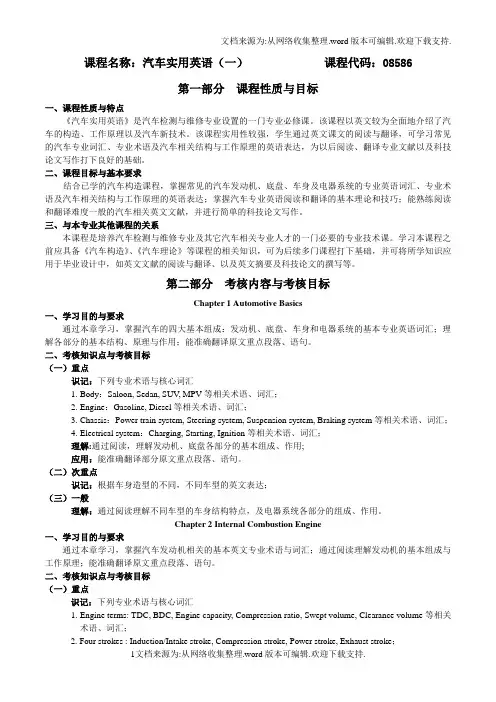
课程名称:汽车实用英语(一)课程代码:08586第一部分课程性质与目标一、课程性质与特点《汽车实用英语》是汽车检测与维修专业设置的一门专业必修课。
该课程以英文较为全面地介绍了汽车的构造、工作原理以及汽车新技术。
该课程实用性较强,学生通过英文课文的阅读与翻译,可学习常见的汽车专业词汇、专业术语及汽车相关结构与工作原理的英语表达,为以后阅读、翻译专业文献以及科技论文写作打下良好的基础。
二、课程目标与基本要求结合已学的汽车构造课程,掌握常见的汽车发动机、底盘、车身及电器系统的专业英语词汇、专业术语及汽车相关结构与工作原理的英语表达;掌握汽车专业英语阅读和翻译的基本理论和技巧;能熟练阅读和翻译难度一般的汽车相关英文文献,并进行简单的科技论文写作。
三、与本专业其他课程的关系本课程是培养汽车检测与维修专业及其它汽车相关专业人才的一门必要的专业技术课。
学习本课程之前应具备《汽车构造》、《汽车理论》等课程的相关知识,可为后续多门课程打下基础,并可将所学知识应用于毕业设计中,如英文文献的阅读与翻译、以及英文摘要及科技论文的撰写等。
第二部分考核内容与考核目标Chapter 1 Automotive Basics一、学习目的与要求通过本章学习,掌握汽车的四大基本组成:发动机、底盘、车身和电器系统的基本专业英语词汇;理解各部分的基本结构、原理与作用;能准确翻译原文重点段落、语句。
二、考核知识点与考核目标(一)重点识记:下列专业术语与核心词汇1. Body:Saloon, Sedan, SUV, MPV等相关术语、词汇;2. Engine:Gasoline, Diesel等相关术语、词汇;3. Chassis:Power train system, Steering system, Suspension system, Braking system等相关术语、词汇;4. Electrical system:Charging, Starting, Ignition等相关术语、词汇;理解:通过阅读,理解发动机、底盘各部分的基本组成、作用;应用:能准确翻译部分原文重点段落、语句。
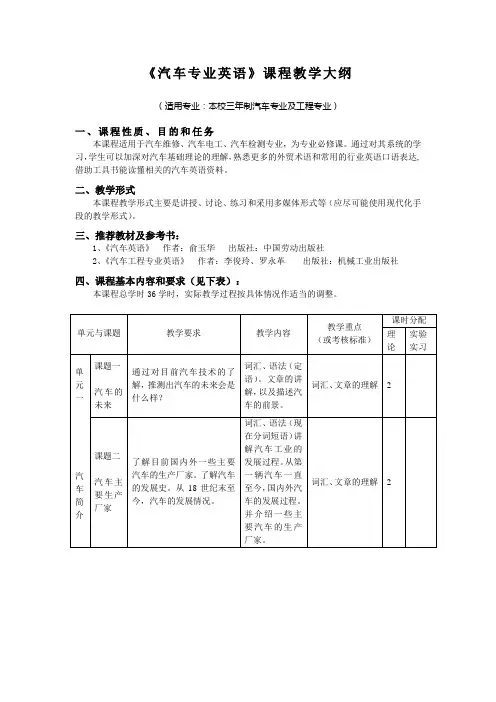
《汽车专业英语》课程教学大纲
(适用专业:本校三年制汽车专业及工程专业)
一、课程性质、目的和任务
本课程适用于汽车维修、汽车电工、汽车检测专业,为专业必修课。
通过对其系统的学习,学生可以加深对汽车基础理论的理解,熟悉更多的外贸术语和常用的行业英语口语表达, 借助工具书能读懂相关的汽车英语资料。
二、教学形式
本课程教学形式主要是讲授、讨论、练习和采用多媒体形式等(应尽可能使用现代化手段的教学形式)。
三、推荐教材及参考书:
1、《汽车英语》作者:俞玉华出版社:中国劳动出版社
2、《汽车工程专业英语》作者:李俊玲、罗永革出版社:机械工业出版社
四、课程基本内容和要求(见下表):
本课程总学时36学时,实际教学过程按具体情况作适当的调整。
执笔人:干文丽审定人:批准人:。
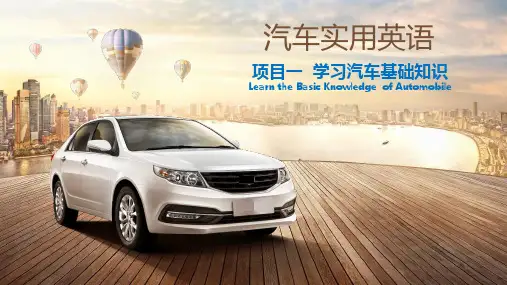
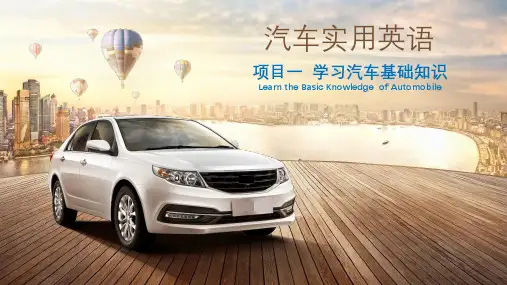
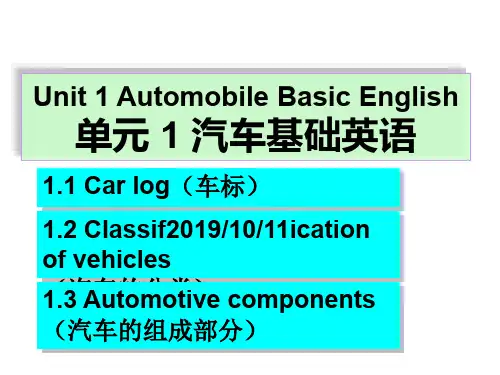
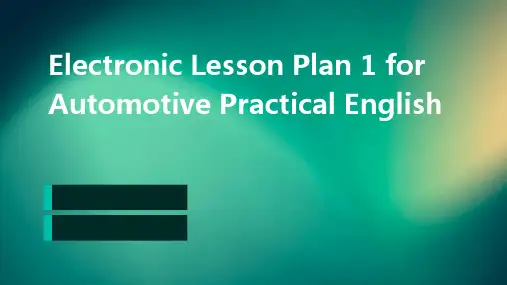
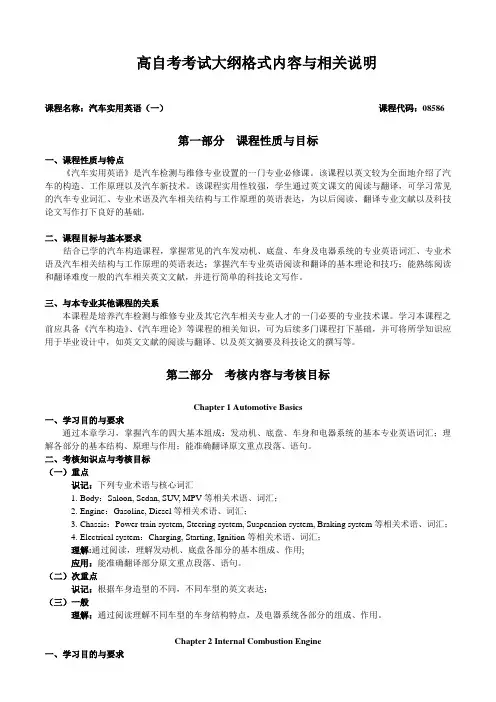
高自考考试大纲格式内容与相关说明课程名称:汽车实用英语(一)课程代码:08586第一部分课程性质与目标一、课程性质与特点《汽车实用英语》是汽车检测与维修专业设置的一门专业必修课。
该课程以英文较为全面地介绍了汽车的构造、工作原理以及汽车新技术。
该课程实用性较强,学生通过英文课文的阅读与翻译,可学习常见的汽车专业词汇、专业术语及汽车相关结构与工作原理的英语表达,为以后阅读、翻译专业文献以及科技论文写作打下良好的基础。
二、课程目标与基本要求结合已学的汽车构造课程,掌握常见的汽车发动机、底盘、车身及电器系统的专业英语词汇、专业术语及汽车相关结构与工作原理的英语表达;掌握汽车专业英语阅读和翻译的基本理论和技巧;能熟练阅读和翻译难度一般的汽车相关英文文献,并进行简单的科技论文写作。
三、与本专业其他课程的关系本课程是培养汽车检测与维修专业及其它汽车相关专业人才的一门必要的专业技术课。
学习本课程之前应具备《汽车构造》、《汽车理论》等课程的相关知识,可为后续多门课程打下基础,并可将所学知识应用于毕业设计中,如英文文献的阅读与翻译、以及英文摘要及科技论文的撰写等。
第二部分考核内容与考核目标Chapter 1 Automotive Basics一、学习目的与要求通过本章学习,掌握汽车的四大基本组成:发动机、底盘、车身和电器系统的基本专业英语词汇;理解各部分的基本结构、原理与作用;能准确翻译原文重点段落、语句。
二、考核知识点与考核目标(一)重点识记:下列专业术语与核心词汇1. Body:Saloon, Sedan, SUV, MPV等相关术语、词汇;2. Engine:Gasoline, Diesel等相关术语、词汇;3. Chassis:Power train system, Steering system, Suspension system, Braking system等相关术语、词汇;4. Electrical system:Charging, Starting, Ignition等相关术语、词汇;理解:通过阅读,理解发动机、底盘各部分的基本组成、作用;应用:能准确翻译部分原文重点段落、语句。
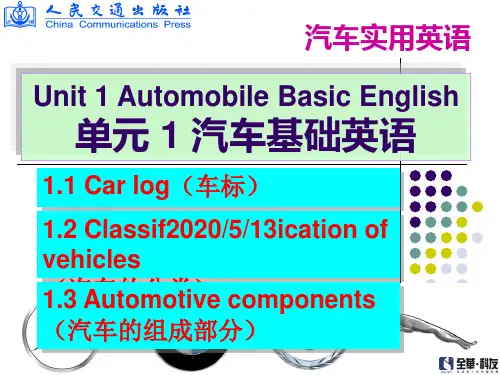
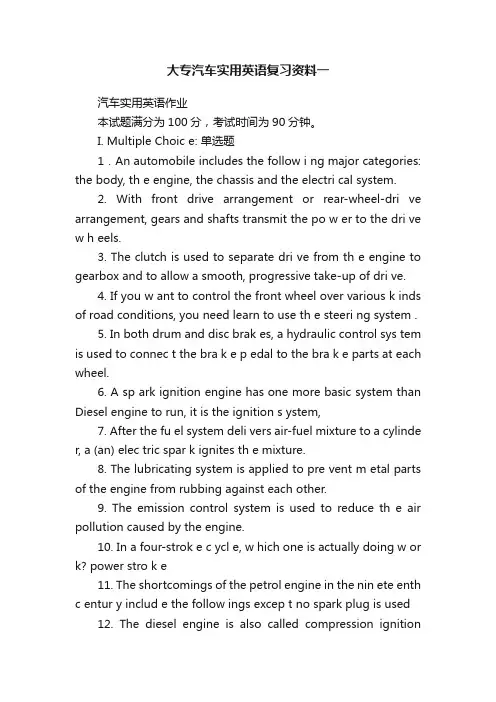
大专汽车实用英语复习资料一汽车实用英语作业本试题满分为100分,考试时间为90分钟。
I. Multiple Choic e: 单选题1.An automobile includes the follow i ng major categories: the body, th e engine, the chassis and the electri cal system.2. With front drive arrangement or rear-wheel-dri ve arrangement, gears and shafts transmit the po w er to the dri ve w h eels.3. The clutch is used to separate dri ve from th e engine to gearbox and to allow a smooth, progressive take-up of dri ve.4. If you w ant to control the front wheel over various k inds of road conditions, you need learn to use th e steeri ng system .5. In both drum and disc brak es, a hydraulic control sys tem is used to connec t the bra k e p edal to the bra k e parts at each wheel.6. A sp ark ignition engine has one more basic system than Diesel engine to run, it is the ignition s ystem,7. After the fu el system deli vers air-fuel mixture to a cylinde r, a (an) elec tric spar k ignites th e mixture.8. The lubricating system is applied to pre vent m etal parts of the engine from rubbing against each other.9. The emission control system is used to reduce th e air pollution caused by the engine.10. In a four-strok e c ycl e, w hich one is actually doing w or k? power stro k e11. The shortcomings of the petrol engine in the nin ete enthc entur y include the follow ings excep t no spark plug is used12. The diesel engine is also called compression ignitionengine because the diesel engine is ignited b y the h eat of compression not by spar k.13. In the compression strok e, one main differ ence be tw e en a diesel engine and a petrol engine is that Both A and B.14. The tw o basic types of fuel inje ction pumps used in th e diesel engine are Dis tribu tor P ump Assembly and in-line type.15. Compared w ith the in-line pump, the D P A has the follow ing ad vantages: self-lubricati ng, easy servicing, low cost of pro duction and acommon single element.16. A result of pressure changes mak es the piston to move up and dow n in th e engine c ylinde r.17. During the pow er stroke, a force of up to 4000 p ounds is suddenly applied to the piston head for 30 to 40 times a second.18. P istons for modern engines are made of aluminum-alloy.19. The function of the piston rings is to all of the above.20. The connecting rod is made of forged alloy steel .21. There are tw o basic typ es of engine val ves: th e exhaust valve and inta k e val ve.22. A valve opens and closes less than 2000 times per mile.23. According to the location of the camshaft, the val ve trains are divided into overhead camshaft typ e and side camshaft type.24. The purpose of valve springs is to to k eep valves close w he n the camshaft is not lifting the valve.25. What type of material is used is dete rmines exactl y by all of th e above.26. Within the gasoline or diesel engine, about 25% of the energy is used to dri ve the vehi cle.27. What problems w ill occur if the eng ine temperatu re istoo high? all of the above28. The function of the w ater jac kets is to remove heat from th e cylinder bloc k on cyli nder head.29. The w ater pump can circulate up to 75 gallons of coolant per hour between th e w ater jac ket and radiator.30. Compared w ith th e fan on older vehicl es, the advantage of th e elec tric fan is that Both A and B31. In the follow ing sentenc es, which one is correc t? The combustion in a gasoline engine must tak e place at a precise momen t of time.32. The conventional ignition system uses a mechanical set of contact poin ts and condensers.33. The function of the primar y w indings is produce magnetic fi eld.34. Which component is not included in the con ven tional ignition system? elec tronic control unit35. The major function of the distribu tor is to Both A and C.36. The spark ignition engine can change the chemical ene rgy contained in fuel into k ine tic ene rgy.37. In the follow ing sentenc es, w hi ch one is correct?T oday’s spark ignition engines can inject th e mixture formatio n direc tly into th ecombustion chamber.38. When can the engine produce maximum pow e r? The throttle val ve is full y open.39. The theoretical ideal for complete combustion is a mass ratio of 14.7:1.40. The 3-w ay catalytic con verter depen ds on a stoichiometric A/F ratio to operate at maximum efficien cy.41. The main requirements for the clu tch are all of the above.42. By the method of transmitting torque, clu tches can be di vided into friction, automatic and hydraulic clu tches.43. By the shape of friction surfac es, clutch es can be divided in to disc types, drum types and cone types.44. In clutches w i th periph eral location of springs, the springs may bulge under the ac tion of centri fugal force.45. Tod ay’s clutch designs sometimes mak e pro vision for tw o indep enden t clutch es: one for starting aw ay from rest; and the other for gearchange.46. Relatively small adaptability to changes of external loads is the distinguishing feature of in ternal combustion engines.47. By the method of changing the gear ratio, the transmissions are divided in to fixed-ratio, stepl ess, and combined transmissions.48. According to the location of shafts, the transmissions can be w ith fixed-axle shafts, rotating-axle shafts, and of combined type.49. In modern transmissions of general-purpose truc k s and bused, th e gear ratio varies between 5.0 and 8.0.50. The characteristic featu res of transmissions w i th c ylindri cal main gear enclosed in one casing are five for w ard gears and one reverse gear.51. The suspension system embrac es springs, control link ages, and shock absorbers.52. In the suspension system, the springs can be of the coil, leaf, pneumati c and torsion bar type.53. Dependent-type front suspension sys tems with solid axle were used on early domestic ve hicles and is still used on some h eavy-du ty tru c k sand farm vehicl es.54. The dependent suspension has a I-beam or solid axle connecting the left and right front-wheel k nu c k les.55. The Macpherson strut suspension is the ideal suspension to meet the need of maximizing the interior dimensions of today’s lightw e ight,front-e ngine, front-drive vehicles.56.The first typ e of k no wn vehi cular bra k es is lock e d w heel.57. The external contracting-band brak e w as designed to solve the problem that small shoes w ould overheat or w ear out, and brak ing pow erw ould be lost.58. In the internal expanding-band brak e, th e band inside of the bra k e d rum is actuated b y a brak e shoe.59. Unlik e inte rnal expanding-band brak es, the inte rnal expanding-shoe brak es re place the flexible bra k e band w i th rigid bra k e shoes.60. The disc brak e w as adopted in a tw o-ton-plus automobile to safel y stop from the 70mph and 80mph highw ay speeds of the tim e.61. The tire loads include three load groups: side load, radi al load and tractive load.62. When the tire is on a dry asphalt surface, the maximum frictional force of the tire (w ithou t sliding) is usually betw een 60%-70%of theradial load.63. The condition of hydroplaning means that the smooth tire rides up on the sur face w ate r.64. In the follow ing sentenc es, which o ne is correc taccording to the tex t? Radial tires have lo w er radial spring rates than bias tires.65. Radial tires w ere fi rst used on sports cars because the y produce good steering sensitivi ty.66. The distance betw een th e cen terlin e of the rim and the mounting face of th e disc is called the w h eel offse t.67. The radial ply tire has the greatest stee ring sensitivi ty.68.The function of the seat bel ts is to hold the occupants in their seats when the vehi cle hits an obstacle.69. In a head-on collision w ith a fixed obstacle at above 40_k m/h, a three-point seat bel t can only offer limite d protec tion.70. By retracting and tightening th e belt strap, the shoulder belt tigh ten er compensates for “belt slac k” and “film-re el effec t” in a collision.71. In a col lision, the w hole procedure of airbag’s inflation and deflation ta k es nearl y 0.1 second _.________________________________________________________________ __________72. The ECU uses the acceleration sensor to measure the de celera tion due to the collision and calculate the change in speed.73. Since the side collision is second only to the frontal collision, the side airbags is equipped in more and more vehicles.74. A refrigeration sys tem consists of fi ve basis par ts, the y are the compressor , th e condense r, the e vaporator , the rece ive r , and the re frigeran tflow control valve.75. The condenser has tw o sets of passages: air passages and refrigerant tubes. 76. The condenser and the evaporator are in fact heat exchangers.77. The receiver is located in a refrige rant line be tw ee n thecondens er and evaporator . 78. The evaporator is located in a box or under the instrument panel of the car .79. A thermostatic expansion valve incl udes a tempera ture sensing bulb, a diaphragm, and a valve that is a spring loaded ball. 80. The compressor is a high pressure pump driven by the engine.II. Match each n umber i tem w i th th e most closel y related lettere d item and w rite your ans wers in th e space provi ded. 按照图片,从给出的词中选择正确单词的字母填入空格当中 1.H K A E C F . fl F G K. w2.—— G —— valve spring 3 1A- pushrodB- camshaft C-cam D-gearE-crankshaft F-flywheel G-rocker armH-connecting rod I- valve spring seat J-throttle K-piston ring L-lifter M-cylinder N-valveO-valve spring P-fuel tank Q-torque_9__a. disengagement _3__b. synchronizer _10__c. booster_4__d. irregularity_5__e. gearbox_2__f. coast_1__g. pneumatic_8__h. lateral_7__i. rotor_6__j. dual 1.filled with air2. move without using power3. a device that make sth. to operate, move ,etc at the same ti me, speed4. state of uneven5. case that encloses a vehicle’s gear mechanism6. double7. brake disc8. of, at, from or towards the side(s)9.disconnection10.device for increasing powerMatch each nu mber item w ith the most closel y related le ttered item and write your ans w ers in th e space provided. (每题2分,共20分)_3__a. orifice__1_b. bulb_10__c. gland_6__d. airbag_7__e. propellant __4_f. deformation _5__g. displacement _8__h. sideways_9__i. tread_2__j. fabric 1.object shaped like certain plants(eg. the onion) with thic k rounded underground stem2. type of cloth, esp one that is woven3.(formal)a hole4.the process of changing shape in a way that is not good or attractive5.the process of forcing sth. out of its position or space6. a bag in a car that immediat ely fills with air if the c ar c rashes, to protect the driver and passengers7. a substance used for making sth. move forwards8. to, t owards or from the side9.outer groove d surface of a tire that is in contact with the road10. a part of your body that produces a chemical substance that your bod y needsIII.Translate the follo w ing phrases and expresses. 翻译下列短语或词组1.disc brak e:盘式制动2.spark ignition and compression ignition: 点燃式和压燃式3.crank shaft and camshaft: 曲轴和凸轮轴4.Emission control system: 排放控制系统5.Multi-c ylinde r engine: 多缸发动机6.Clearance volume: 燃烧室容积7.gasoline mixed w ith air: 空气和汽油混合物8.jump across the gap of spark plug: 火花塞跳火间隙9.turn through a half revolu tion: 旋转半周10.valve seat: 气门座11.liquid (w ater )-cooling syste m: 水冷12.cylinde r order: 气缸顺序13.shorting-out: 短路14.timing-re tarded: 点火滞后15.manifold injection: 进气歧管喷射16.3-w a y catalytic con ver ter: 三元催化17automatic clutches自动离合器18. peripheral location of springs弹簧周布置19. centrifugal force离心力20.gear chan ge lever变速杆21.intermediate shaft中间轴22. straight-tooth gear-w h eels直齿齿轮23.independent front suspe nsion独立前悬架24. handling characteristics操纵性能25. Macpherson strut-type suspension麦佛逊立柱型悬架26.dependent suspension非独立悬架27.coefficient p f fri ction摩擦系数28. steering sensitivity操纵灵敏性29. drop center w h eel rim深式轮辋的车轮30.collide head on迎面碰撞31. Electronic Control Unit电子控制单元32. side impact detection侧向碰撞检测33.peripheral acceleration轴向加速34. heat exchanger热交换器35. fixed orifice固定量孔36. hoses and tubing管路IV. F ill in the blan k s w ith the w ords give n below. Change th e form w he re necessary. 用单词的正确形式填空________________________________________________________________ __________________________________________________________________________ __________t from the fric tion of the ropes on his sk 2. The phone w on’t w or k i f it isn’t charging up.3. Their routine w or k is to cruis e around the Mississippi.4. The w h eels are neede d lubricate, please put some oil on it.5. The carpets have b een w orn, w e ha ve to buy a ne w one.6. Petrol is __ combustible ____, so w e should keep it far from the fi re.7. Iron can _ transmit _____ heat.8. Their job is to _ alignment _____ straw into block s for burning.9. The bread w ill harden _ if you don’t cover i t.10. The bridge w as gradually brought into _ compressing_____._ evaporates _____ in the sunshine.2. Before the comprehensi ve test, you ’d bett er do some w ar m-up exer cise.3. The demonstrations in London and P airs happened _ simultaneously _.4. The company is taking a new m easure to _ boost ___ their export trade.5. The electrical charge can be eith er _ positive ____ or negative such that li k e charges rep el and opposite charges attract.6. Who is responsible for the _ transfer _____ of military supplies?7. He w as drin k ing a glass of w ine _ diluted _____ with w ater . 8. The ball ___ bounces _______ tw ic e before hi tting th e net. 9. The mist quick l y _ dissipates _____ as the sun rose.10. P ut a _ sealing _____ here, it will help pre ven t oil leak ing out.1. Their happiness was to be sadly _ appreciable _____.2. Her help has made an __ effected ____ difference.3. I have eaten too much. My st omach is _ bul ge _____.4. This herbal medicine __ transients ____ a good cure for his disease.5. The cells have a series of _ intermediate ___ stages before they develop full y.6. The teacher is explaining the configuration of th e earth’ssurfa ce for the students.7. Traveling two days on end, he felt sick because of the harshness of the road.8. The republic was declared a fully __ inde pendent __ state.9. That woman __ shield ____ her child with her body.10. How much longer is the investigation going t o _ drag ____ on?1. 2. Just _ split __ the cake into three and leave one piece for Simon. _ symmetric ____. 5. It is reported that two ships came into __ collision ____ and 9 people were killed. 6. The manager _ slacken _____ his tie, ready now to relax. 8. She wiped the _ sweat _____ off her forehead with a towel. 10. His old clothes were all _ clumped_____ together in a corner. V . Translate the follo w ing sentences. 1. With the in troduction of compu ters and elec tronic de vices, th e modern vehicle ’s electrical system is becoming more and more c omplex.随着计算机和电子装置的引进,现代车辆的电子系统变得越来越复杂。
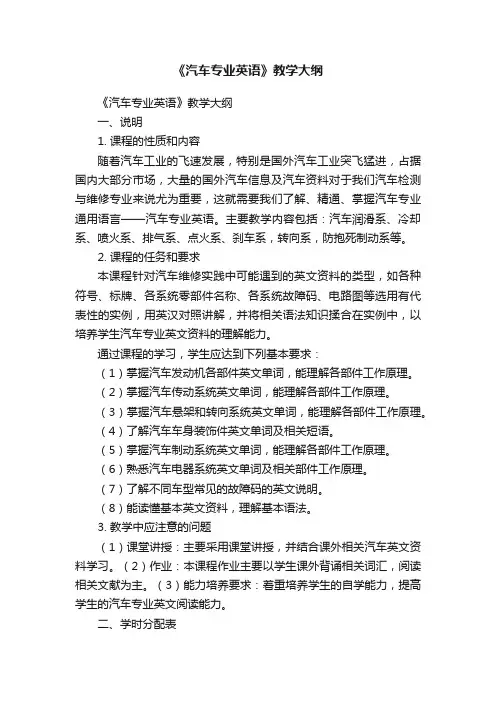
《汽车专业英语》教学大纲《汽车专业英语》教学大纲一、说明1. 课程的性质和内容随着汽车工业的飞速发展,特别是国外汽车工业突飞猛进,占据国内大部分市场,大量的国外汽车信息及汽车资料对于我们汽车检测与维修专业来说尤为重要,这就需要我们了解、精通、掌握汽车专业通用语言——汽车专业英语。
主要教学内容包括:汽车润滑系、冷却系、喷火系、排气系、点火系、刹车系,转向系,防抱死制动系等。
2. 课程的任务和要求本课程针对汽车维修实践中可能遇到的英文资料的类型,如各种符号、标牌、各系统零部件名称、各系统故障码、电路图等选用有代表性的实例,用英汉对照讲解,并将相关语法知识揉合在实例中,以培养学生汽车专业英文资料的理解能力。
通过课程的学习,学生应达到下列基本要求:(1)掌握汽车发动机各部件英文单词,能理解各部件工作原理。
(2)掌握汽车传动系统英文单词,能理解各部件工作原理。
(3)掌握汽车悬架和转向系统英文单词,能理解各部件工作原理。
(4)了解汽车车身装饰件英文单词及相关短语。
(5)掌握汽车制动系统英文单词,能理解各部件工作原理。
(6)熟悉汽车电器系统英文单词及相关部件工作原理。
(7)了解不同车型常见的故障码的英文说明。
(8)能读懂基本英文资料,理解基本语法。
3. 教学中应注意的问题(1)课堂讲授:主要采用课堂讲授,并结合课外相关汽车英文资料学习。
(2)作业:本课程作业主要以学生课外背诵相关词汇,阅读相关文献为主。
(3)能力培养要求:着重培养学生的自学能力,提高学生的汽车专业英文阅读能力。
二、学时分配表教学内容总学时讲授学时训练学时Unit 1 Automotive Basics1、New Words and Expressions 1 12、Explaining of the text 2 23、Reading material 1 1 Unit 2 Automotive Engine1、New Words and Expressions 1 12、Explaining of the text 2 23、Reading material 1 1 Unit 3 Automotive Lubrication System1、New Words and Expressions 1 12、Explaining of the text 2 23、Reading material 1 1 Unit 4 The Cooling System1、New Words and Expressions 1 12、Explaining of the text 2 23、Reading material 1 1 Unit 5 Fuel Injection System1、New Words and Expressions 1 12、Explaining of the text 2 23、Reading material 1 1 Unit 6 Exhaust System1、New Words and Expressions 1 12、Explaining of the text 2 23、Reading material 1 1 Unit 7 The Ignition System1、New Words and Expressions 1 12、Explaining of the text 2 23、Reading material 1 1 Unit 8 Clutch1、New Words and Expressions 1 12、Explaining of the text 2 23、Reading material 1 1 Unit 9 Automatic Transmission1、New Words and Expressions 1 12、Explaining of the text 2 23、Reading material 1 1 Unit 10 The differential1、New Words and Expressions 1 12、Explaining of the text 2 23、Reading material 1 1 Unit 11 Brake System1、New Words and Expressions 1 12、Explaining of the text 2 23、Reading material 1 1 Unit 12 Steering System1、New Words and Expressions 1 12、Explaining of the text 2 23、Reading material 1 1 Unit 13 Suspension System1、New Words and Expressions 1 12、Explaining of the text 2 23、Reading material 1 1 Unit 14 ABS and TCS1、New Words and Expressions 1 12、Explaining of the text 2 23、Reading material 1 1 Unit 15 Cruise Control Systems1、New Words and Expressions 1 12、Explaining of the text 2 23、Reading material 1 1 Unit 16 Electric Cars1、New Words and Expressions 1 12、Explaining of the text 2 23、Reading material 1 1 总课时64 48 16三、教学要求、内容及建议Unit 1教学要求:掌握汽车各部分如车身,底盘,引擎等的英文名称,了解汽车各部件的基本功能以及汽车各系统基本工作原理。
汽车实用英语一、单词拼写(汉语和首字母给)S(tructure)构造C(hassis)底盘C(ylinder)气缸C(onvert)转变E(xhaust) 排气,废气;排气,耗尽C(omponent)成分,部件,零件S(troke)冲程,行程S(uspension)悬挂S(teer)驾驶;(车辆)转向机构B(rake)制动器,刹车;制动M(echanism)机械机构T(orque)转矩,扭矩T(ransmission)变速器,传动装置C(lutch)离合器B(alance)使平衡H(ydraulic)液压的,水力的F(riction)摩擦,摩擦力B(attery)电池Transportation 交通Manufacturer 制造商Marquee 汽车的型号或式样Bolt n. 螺栓v.用螺栓连接crankcase n. 曲柄箱bearing n.轴承crankshaft n.曲轴piston n.活塞flywheel n.飞轮reciprocate v.往复,做往复运动engage v.连接,结合valve n,气门,阀门,阀Symptom n.迹象,症候Coolant n.冷却液Radiator n.散热器,冷却器Thermostat n.恒温器,温度自动调节器Maintenance n.维修,保养Concept n. 观念,思想,概念Store v. 储存Vaporize v.(使)蒸发Injector n.喷油器,喷(注)射器Nozzle n.喷嘴Pressurize v.对(给)。
加压Silence v. 消除(噪音)Muffler n.消声器Resonator n.共振系统,(汽车)辅助消声器Pose v. 造成,形成;提出Evaporate v.蒸发,挥发Roadster n.双座敞蓬轿车,跑车。
Essential a.基本的,本质的,必要的,必不可少的,Regulate v.调节Agent n.代理人(商)Transfer n.\v.传导,传递Antifreeze n.(汽车水箱)防冻液,(化)防冻剂Housing n.外壳,外罩Enclose v.封入,装入Drain v.排出,排泄,排水Appropriate a,适当的Lubricate v.使润滑,加润滑油Regulator n.调节器Contaminant n.致污物,污染物Incorporate v.合并,并入Maintain vt, 保持,维持,保养,维修Standardize vt.使符合标准,使标准化Complex a.复杂的,综合的Electronics n,电子元件Module n.组件,模块,电子控制总成Sandwich v.夹入Linkage n.联动装置Remedy n.补救Headquarter n.总部Vt.设总部于,,,,,Accessory n.附属,附件,零件Install vt. 安装,安置,装配Ratio n.比,比率Particular a,特殊的,特别的,独特的Reverse v.使倒退Accelerate v.加速,促进Strain n.拉力,张力,应变Multiply v.成倍的增加,增加Impose v.\把。
《汽车实⽤英语》复习指导书《汽车实⽤英语》复习指导书本课程的内容是教学⼤纲规定的主要内容,学⽣在学习过程中,依据教学⼤纲规定的“了解、掌握、重点掌握”三个层次来把握。
了解:要求学员对这部分内容知道。
掌握:要求学员对这部分内容能够理解并能够⽐较完整地回答;该部分主要是本课程的基本内容概念、基本理论和基本⽅法。
重点掌握:要求学员对这部分内容能够深⼊理解并熟练把握,同时能准确地应⽤。
复习的基本要求⼀、全⾯、认真阅读⽂字教材,在系统、深刻领会教材的基本理论和⽅法基础上,把握住重点内容(重点内容列在后⾯)。
复习过程要结合录像教材、直播课堂,结合⽹上资源等进⾏。
⼆、注意运⽤所学理论和⽅法对问题进⾏分析。
本课程是⼀门实践性较强的课程,学⽣应注重运⽤这门课程中所学的基本原理对汽车的实⽤电路进⾏分析。
三、认真复习平时作业,注意总结辅导教师对⾃⼰平时作业所给的意见,结合作业讲评和交流情况加深对课程基本内容的理解和掌握。
题型举例I.Translate the following phrases and expresses.将以下短语和词句翻译成汉语。
(每题2分,共20分)1.automatic clutches 动离合器2.dependent suspension ⾮独⽴悬架3.coefficient pf friction 摩擦系数II. Reading Comprehension: 阅读理解III. Multiple Choice: Circle the letter in the correct answer. 选择题:将正确答案前题号放在所给的括号内。
(每题1分,共20分)()1. In the suspension system, the springs can be of the coil, leaf, pneumatic and __A____ type.A torsion barB strutC conicalD cylindricalIV Match each number item with the most closely related lettered item and write your answers in the space provided. 将和左侧相匹配的答案前题号填写在空格处。
xx省高等教育自学考试大纲08586汽车实用英语(一)xx技术师范学院编xx省高等教育自学考试委员会办公室说明:采用教材:《汽车实用英语》,韩建保编著,高等教育出版社,2009年。
参考文献:《实用汽车维修英语》,王锦俞邹军新编,机械工业出版社,2004年9月第1版。
一、考试的重点内容Unit1 History and Basic Components of Automotives(第一单元汽车发展简史及其基本组成部件)1.掌握汽车各总成及其主要部件的英文词汇和短语;2.掌握描述系统的安装位置和组成部件的句型;3.能够用简单的英文语句描述汽车各系统的基本功能和工作原理。
Unit2 Challenges for Repair Shops from Car’s Innovative Features(第二单元轿车新技术特征对检测维修工作的挑战)1.掌握轿车新技术特征和故障诊断与维修方面的英文词汇和短语;2.熟悉车型的命名惯例;3.能够用简单的英文语句描述轿车新技术特征。
Unit3 Automotive Diagnostic and Test Procedures(第三单元汽车故障诊断与检测方法)1.掌握汽车故障诊断与检测方法方面的英文词汇和短语;2.掌握汽车故障诊断过程主要工作内容的英文语句;3.掌握描述简单故障的英文语句。
Unit4 Years of Automotive Tools(第四单元汽车维修工具的百年发展史)1.掌握汽车维修工具的英文词汇和短语;2.掌握描述汽车维修工具的工作原理和进行各种调整操作的句型。
Unit5 Automobile Electrical Systems and Preventive Maintenance(第五单元汽车电气系统及其预防性维护保养)1.掌握汽车电气系统的英文名称以及故障现象和维护保养方面的英文词汇和短语;2.能够用简单的英文语句描述电气系统的故障现象。
Unit6 Electronic Throttle Control and its noteworthy capabilities(第六单元电子节气门控制及其主要优点)1.掌握汽车电子节气门的基本组成部件的英文词汇和短语;2.能够用简单的英文语句描述汽车电子节气门的功能。
Unit7 Preventive Maintenance Tech Tips: Fuel Filter, Cap & Lines(第七单元燃油滤清器、油箱盖和油路的预防性维护保养技巧)1.掌握燃油滤清器、油箱盖和油路方面的英文词汇和短语;2.掌握描述零件安装和拆卸过程中各项注意事项的英文语句。
Unit8 Head Gasket Failure Reasons, Replacement and Sealing(第八单元气缸盖密封垫的故障原因、更换与密封)1.掌握气缸盖密封垫方面的英文词汇和短语;2.理解并熟记气缸盖密封垫失效原因的8个英文小标题。
Unit9 Cooling System and Troubleshooting(第九单元冷却系统及其故障排除)1.掌握汽车冷却系统方面的英文词汇和短语;2.能够用简单的英文语句描述冷却系统的工作原理。
Unit10 The New Diesel Technology and Its Training & Repair(第十单元柴油发动机新技术进展及其培训与检修)1.掌握柴油发动机主要新技术特征方面的英文词汇和短语;2.分析并掌握简述复杂系统工作原理的英文惯用语句;3.通过注释语句体会专业英语翻译技巧。
Unit11 Preventive Maintenance Tech Tips for Brake Discs(第十一单元制动盘的预防性维修保养技巧)1.掌握制动盘预防性维修保养方面的英文词汇和短语;2.能够用简单的英文语句描述制动盘的故障原现象和故障原因。
Unit12 Rapid Diagnosis of Engine No-Start Faults(第十二单元发动机无法起动故障的快速诊断)1.掌握发动机无法起动的原因及快速诊断方面的英文词汇和短语;2.揣摩注释语句的中英文表达,掌握译文中不使用定冠词时的过渡性表达技巧。
Unit13 Steering & Suspension Where is the Wear(第十三单元如何检查转向和悬架部件磨损导致的故障)1.掌握转向和悬架系统方面的英文词汇和短语;2.能够用简单的英文语句描述转向和悬架系统的常见故障症状。
Unit14 Problems Caused by Worn or Damaged Suspension Bushings(第十四单元正确诊断轴衬磨损导致的悬架故障症状)1.掌握轴衬磨损导致的悬架故障方面的英文词汇和短语;2.掌握描述汽车金属部件之间各种相对运动产生的响声的英文表达。
Unit15 New Technical Features of the US2004 Import Cars(第十五单元美国2004年新款进口轿车的新技术特征)1.掌握美国新款进口轿车的新技术特征方面的英文词汇和短语;2.能够用简单的英文语句描述转子发动机的基本结构形式和工作原理。
3.在介绍新车型、新配置和新技术特征的文章中,熟悉插入语和英文缩写的应用。
Unit16 4WD & AWD Drive-trains Service Tech Tips(第十六单元四轮和全轮驱动系统的维护保养技巧)1.掌握四轮驱动和全轮驱动方面的英文词汇和短语;2.掌握四轮驱动和全轮驱动系统的共同点和差异。
Unit17 When an SUV’s Ride Deteriorates(第十七单元运动型多功能汽车行驶平顺性恶化时的故障检测)1.掌握汽车行驶平顺性恶化方面的英文词汇和短语;2.理解注释语句的专业含义并掌握这类语句的翻译技巧。
Unit18 Specifications and Selection of Fluids for Automotive(第十八单元各种车用油液的技术参数及其选用原则)1.掌握各种车用油液及其技术参数方面的英文词汇和短语;2.掌握机油的分类标准及其性能指标;3.能够用简单的英文语句描述车用油液等级及选用原则。
Unit19 Diagnostic Information of Eight Major European Nameplates(第十九单元欧洲八大品牌汽车故障自诊断技术透视)1.掌握欧洲八大品牌汽车以及故障自诊断方面的英文词汇、缩略语和短语;2.掌握故障码的读取方式、插孔选项和自诊断连接器等技术概念和装置的语句特点;3.能够用简单的英文语句描述各品牌汽车的故障自诊断技术的特点。
Unit20 Technical Features and Service Tips of Hybrid Vehicles(第二十单元混合动力车辆的技术特征与维修技巧)1.掌握混合动力车辆技术特征方面的英文词汇和短语;2.掌握IMA、THS、ATF-Z1、5W-30 SJ等术语的技术内涵。
Unit21 Wheel Alignment and Troubleshooting(第二十一单元车轮定位及其故障排除)1.掌握轿车车轮定位参数及故障现象方面的英文词汇和短语;2.了解不正确的车轮定位参数对轿车相关部件的损害及其这种损害的比较规范的英文表达;Unit22 New Automotive Parts Offer Solid Value for Customers(第二十二单元新型汽车配件带给客户的实在好处)1.掌握一些体现细腻逻辑推理的英语语句;2.理解汽车领域商业策划的英语表达特点,了解汽车商业领域的一些特殊的价格现象。
Unit23 Make Your Shop A Model of Efficiency(第二十三单元如何布置出一个高效运行的汽车维修厂)1.掌握汽车维修厂方面的英文词汇和短语并熟悉主要维修保养设备的英文名称;2.了解维修车间工作空间和设备布局示意图的基本绘制规范。
Unit24 Access to Service Information for European Vehicles(第二十四单元如何获取欧洲汽车的保养维修技术资料)1.掌握获取欧洲汽车维修保养技术资料的主要途径;2.通过上网查询,了解更多的汽修信息专业网站。
Unit25 Servicing the 2004 Light Truck(第二十五单元 2004年新款轻卡的维修与保养)1.掌握2004年新款轻卡的新技术特征及其维修保养方面的英文词汇和短语;2.掌握新车型以及性能指标的英文表达。
Unit26 Upgrade Your Credentials through ASE(第二十六单元美国汽车维修技师资格认证体系及试题编写和效果评估)1.熟悉汽车维修技师资格认证协会的产生背景、运作模式、考试形式以及试题的编写原则;2.了解如何评价认证汽车维修技师的水平。
Unit27 Diagnosis of Engine Malfunctions by Volumetric Efficiency(第二十七单元利用容积效率确定发动机故障原因)1.掌握加减乘除运算的英文口头表达语句;2.通过了解插图和列表的内容,掌握分析比较图中曲线变化趋势的英文基本语句;3.理解根据计算的容积效率确定发动机的故障原因。
Unit28 Possible Choices for Replacements of Engines(第二十八单元更换发动机的八种可能的选择)1.掌握更换发动机时常用的的英文词汇和短语;2.熟悉更换发动机时发动机的8个主要来源。
Unit29 Buying a Previously-owned Car and Technical Inspection Checklist(第二十九单元选购二手车的好处与技术检测项目)1.掌握许多能看到河触摸到的汽车零部件和结构部位的英文名称;2.掌握描述零部件和结构部位缺陷或损坏的实用英文语句;3.掌握汽车技术英语方面的一些比较简单的口语化英语语句。
Unit30 Replacement or Service of Engines with Troubles(第三十单元发动机大修或更换的利弊分析)1.掌握汽车检修技术资料中常见的英文专业词汇;2.掌握贷款业务中的常用英文词汇和短语;3.能够用简单的英文语句描述维修工作中的利润和风险分析。
二、其余部分为非重点内容三、试卷结构及考题形式《汽车实用英语》考试采用笔试方式,满分100分,考试时间150分钟。
考试试卷共分为以下五部分:(一)词汇本部分包括两节,共20题,每题1分,满分为20分。